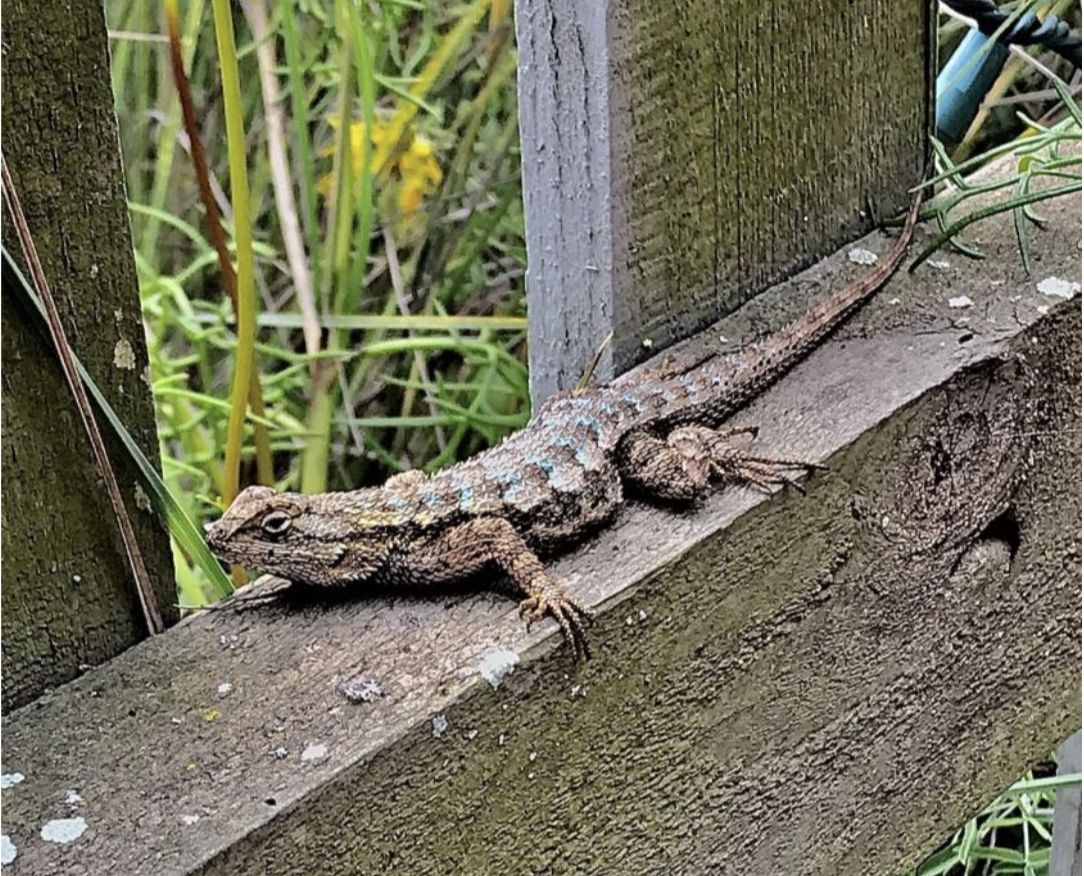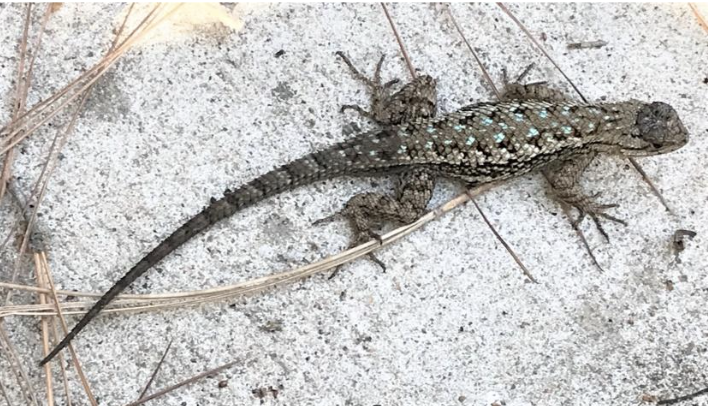Lizard Safari
by Teresa Everett
(reprinted with permission from CNPS Newsletter)
This morning, I was watching a 6-inch-long lizard scampering up the trunk of my Western Redbud tree. Suddenly the lizard froze, tilted its head, and—in a move that would have made a leopard proud—launched itself from the tree, soared about 3 feet through the air, and landed on the ground with the wings and legs of an unidentified victim protruding from its mouth. Who needs to travel all the way to Africa to see predators stalk, leap, or run down prey? One just needs to take the time to sit in the garden and watch our common Western Fence Lizards (Sceloporus occidentalis)—also known as “blue-bellies” or “swifts”—and you will observe exciting hunts, epic battles, and magnificent territorial and mating displays.
Adult Western Fence Lizard – on fence! Photo by Bonnie Nickel
For those who grew up in California, the sight of a blue-belly doing “push-ups,” racing along a fence, or rustling through the leaves was so common that we often forgot to appreciate the wonders of these little reptiles. Luckily, Western Fence Lizards are still common throughout California, Arizona, Oregon, and Idaho. Blue-bellies have been around as a distinct species for millions of years, living in almost every California habitat from sea level to 10,000 feet (excluding the desert), and are the species most often seen in our area. You will most likely find them sunning themselves on paths, rocks, logs, walls, trees, and fence posts or rustling in the plants next to pathways. Western Fence Lizards are considered a keystone species in many habitats, not only because they prey on a large number of insects and spiders but also because they are an important food source for other reptiles, birds, and mammals.
Adult lizards range between 4.5 to 6 inches long from snout to tail and vary in color from gray to brown to nearly black. The mottled brown and tan stripes running along their backs remind me of Native American basketry designs, and the turquoise and emerald scales on their backs look like semiprecious jewels! Their undersides are light colored and edged with bright blue stripes. Males have more brightly colored blue on their bellies as well as a blue patch on their throats. They also have a yellow stripe along the femoral pores that line the back of their thighs; these pores exude a waxy substance that the males use to mark their territories. Western Fence Lizards can also change color throughout the day, most likely for thermoregulation rather than camouflage.
Blue throat patch visible. Photo by Bonnie Nickel
Colorful pattern on back reminiscent of Native American basket design. Photo by Bonnie Nickel
Swifts are strictly diurnal: active during the day and retiring to rocky shelters, crevices in wood, or abandoned ground squirrel burrows or woodrat nests at night. They are slow and sluggish in the morning, but after a nice warmup in the sun they are ready to dash off at up to 9 feet per second—no wonder they are called swifts! From mid-fall to about March, adult blue-bellies will seek shelter and enter a hibernation-like state called brumation, during which they are very susceptible to predation. To avoid becoming a meal, they have evolved a strategy that other vulnerable animals, such as birds, aquatic mammals, and other reptiles, use: they sleep with one eye open. This is called asynchronous eye closure (ASEC) and it mediates the trade-off between the need to remain vigilant and the need to sleep. During ASEC, the brain hemisphere neurologically connected to the closed eye sleeps while the hemisphere associated with the open eye stays awake and alert for predators. Yes, they can really “sleep with one eye open”!
And what about their third eye? Yes, our little blue-bellies, like many other lizards, amphibians, sharks, and fish, have a third or parietal eye, which is visible on the top of their heads as a large, opalescent, triangular scale with a tiny greenish-white dot in the center. This eye, which contains photoreceptive cells and a rudimentary retina and lens, does not form images but perceives light, shadow, and blue and green colors. The parietal eye is associated with the lizard’s pineal gland, which is active in triggering production of hormones that stimulate the lizard to seek sun or shade, change activity levels, initiate breeding behaviors, sleep, and brumate. Blue-bellies also use their third eye as a sun-calibrated compass telling the lizard where it is and how to find its way home.
Home for the Western Fence Lizard is a well-defended territory that they mark with scent glands as well as with “push-up” displays and sometimes epic battles. I once watched two large swifts engage in a brutal wrestling match complete with vicious jaw-locking bites for over 30 minutes! It was like a scene out of the 1960 film The Lost World. Female lizards also use these displays to mark out their territories. Blue-bellies will try to control the same territories year after year, and since they can live from 5 to 7 years, you can get to know the individual characters in your gardens. During their push-up displays, the lizards will stand sideways to the object of their interest (to look bigger), flatten their sides (to look even larger and to show off their blue side stripes), and then pump out the push-ups. Males will also flare their dewlaps to show off their blue throat patches. The best time to look for these behaviors is from March to June when the lizards are emerging from brumation and starting to stake out territory and court a mate.
During breeding season, you can also observe the lizards shuddering, head-bobbing, tail raising, and even licking each other. Swifts mate in the spring but do not breed until the spring of their second year. Females lay 1 to 3 clutches of eggs between April and July, containing from 3 to 17 eggs (usually around 8) per clutch. Because their eggs desiccate easily, the females like to lay them in sheltered, shady areas in loose moist soil. The eggs hatch in about 2 months. The tiny velvety tan baby lizards are so darn cute!
Watching these small predators hunt is just amazing. Fence lizards eat beetles, flies, bees, caterpillars, ants, other insects, larvae, and spiders—just about any arthropod small enough to swallow. Swifts do not stalk their prey but sit motionless on a spot where they will blend in and wait for an unsuspecting victim to crawl or fly by. The lizard will then explode off its perch to either run down, leap down upon, or leap up into the air (over ½ a foot straight up) and nab its meal on the tip of its sticky tongue.
Baby emerging from nest. Photo by Bonnie Nickel
Regenerating tail after tail drop. Photo by Bonnie Nickel
Blue-bellies themselves are also frequently preyed upon. Because they tend to hang out on prominent points, they make an easy meal for snakes, birds, raccoons, skunks, shrews, and domestic cats. Luckily, they have a pretty ingenious trick: they can voluntarily detach their tail when attacked, leaving it either on the ground wriggling furiously to distract the predator or in the predator’s mouth, tricking the animal into thinking it has caught the lizard. Fence lizards’ tails have evenly spaced weak spots, and when the lizard contracts its muscles around these fracture planes, the muscles, blood vessels, nerves, and vertebrae all break at the same time, causing the tail to drop and thus giving the lizard time to escape. The ruptured blood vessels immediately constrict to minimize blood loss. The lizard then partially regenerates its tail over a period of several weeks to months. The new tail section contains cartilage rather than bone, and the skin differs in color and texture from the original. This process costs the lizard a great deal in physical resources, so please be careful when handling lizards to prevent tail drop.
Western Fence Lizards are quite a wonder, but here is one of the most interesting facts about them: they may be a large factor in why Lyme disease is not as widespread in the western US as it is back east. Swifts have been found to be immune to Lyme disease because their blood contains immune factors that kill Borrelia burdorferi, the bacterium that causes the disease. When a juvenile Western Black-legged Tick (the insects that carry this bacteria in their gut and transmit Lyme disease when feeding) bites a fence lizard and injects B. burdorferi into its bloodstream, the lizard’s immune factors kill the bacteria, thus preventing infection. Conversely, when the tick consumes the lizard’s blood, the immune factors in the blood kill the bacteria residing in the juvenile tick, permanently clearing it of B. burdorferi before the tick reaches mature size and feasts on larger mammals. This may be why the percentage of ticks that carry the Lyme disease bacterium is much lower in the west than in the northeast. The Southern Alligator Lizard is also immune to Lyme disease and contributes to our low infection rates.
I hope you have gained a better understanding of and appreciation for the Western Fence Lizard. Now, grab a cool drink and go on a lizard safari in your own backyard!
Teresa Everett is a native garden educator and native plant enthusiast. She is a member of the Gardening Committee, and her home was on the CNPS-SD Garden Tour a few years ago. Teresa has worked for Moosa Creek Nursery as a retail sales and gardening specialist and wrote for their blog “Creekside Chat” until 2018. She has also given many presentations on native gardening at nurseries, gardening clubs and conservation organizations.





